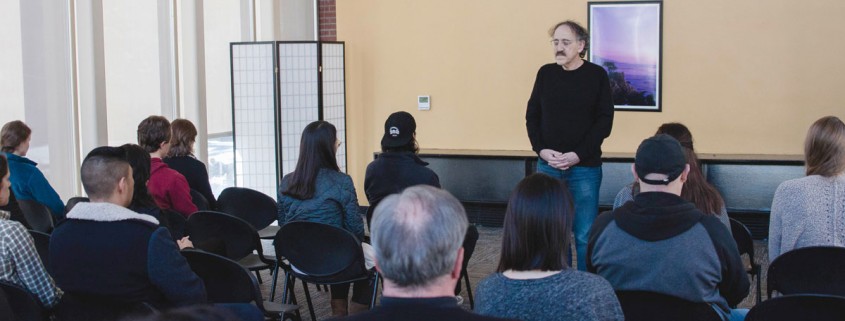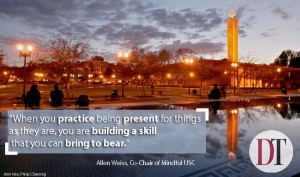Mindful USC teaches stress relief to students
Mindful USC, which started in the fall of 2014 as a budding initiative for mental and physical health, has grown exponentially this semester.
The program, guided interdisciplinarily by departments as disparate as the School of Cinematic Arts and the Office of Religious Life, has a full schedule of 13 classes being offered in the spring semester. Despite this expansion, the pursuit of Mindful USC is the same: to provide students with the tools for better stress management and to be able to experience and live in a moment.
In its infancy, Mindful USC carried out five-week courses in the Marshall School of Business and SCA. Expanding these piecemeal courses into full classes was a result of the immense success of the programs.
Allen Weiss, the co-chair for the Steering Committee of Mindful USC and professor in the Marshall School of Business, has taught at InsightLA for more than 10 years. He learned how to teach meditation at Spirit Rock Meditation Center. He said that the draw of mindfulness has many sources.
“The people come in because of anxiety, depression, a lot of self-judgment and just generally people feel that their life is just not settled down,” Weiss said. “Mindfulness helps to reduce all of that.”
Most of these classes are led by trained staff from InsightLA, a mindfulness meditation organization based in Santa Monica that is affiliated with Spirit Rock Meditation Center, the Center for Religion and Spirituality at Loyola Marymount University, the Insight Meditation Society, the Pediatric Pain Program at UCLA, the Innerkids Foundation and the Institute for Meditation and Psychotherapy.
As mindfulness has gained mainstream popularity and acceptance on the USC campus, students have found outlets to practice it further among the residential halls. Sophomore Peter Bergmann is a resident assistant in Birnkrant Residential College. He leads “Mindfulness Mondays” for his residents — a group mindfulness session that takes place at the beginning of the week. Bergmann notes that an initial common misconception about mindfulness is that it is too time-consuming.
“Everybody always has this idea that they don’t have time for mindfulness, that’s it going to take 30 minutes or an hour here and there,” Bergmann said. “The huge thing [my residents] get from it is that it’s bang for buck. You can spend five minutes doing some practices and it just really really gives you benefits throughout the day.”
A repeated benefit of mindfulness is the ability to perceive one’s emotions at a distance, according to Weiss.
“As human beings we have a tendency to just react to everything. We react to negative things that happen to us; we want to change things, we want to fix things, we don’t like the way things are, and we kind of go through life this way,” Weiss said. “But when you’re doing all of that, you’re not really seeing the world very clearly. When you practice being present for things as they are, you are building a skill that you can bring to bear.”
Senior Lillie Moffett is a resident assistant that also practices mindfulness with her residents. Emotional clarity is a huge benefit that she has seen in her participating residents.
“For one of my residents specifically, it was sort of a place for him to realize that he had problems that were deeper than could be solved through meditation,” Moffett said. “He realized that he needed to confront some problems that he was having. When you’re so busy, you are kind of ignoring the fact that you feeling a certain way, as opposed to when you have a space to stop, think and breathe.”
In her own life, Moffett has seen mindfulness help her focus on tasks and get more work done. But this skill is one that takes patience and can potentially take a long time to learn.
“I didn’t see effects for literally a year and a half. You have to practice, and it’s not going to come right away,” Moffett said.


